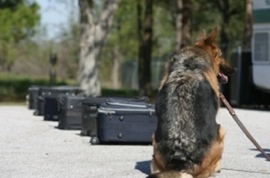Drug Dogs and Detector Dogs
While most people know about drug dogs, at least by name, this seems to be all that the general public is familiar with. In reality, there are a handful of jobs that the term "detection dog" covers. with the keenest sense of smell of all creatures, the dog is heavily relied upon by border patrols officers and other crime fighters.
Dogs have been trained to detect drugs and firearms (OK, you may have known about that one, too) since 1978. By 2003, currency detector dogs were added to the force. Most commonly used dogs are the Labrador Retrievers.
In 2005, the Canadian Food Inspection Agency added food, plant and animal detector dogs. Beagles are normally used for this type of detection.
In Malaysia, dogs are used to sniff out polycarbonates, chemicals used to manufacture DVDs, believe it or not. What for? To be used against DVD piracy!
We're going to focus on drug dogs, though, and how they are chosen and trained for their huge tasks.
Testing to Choose Potential Drug Detection Dogs
Before a drug dog is chosen, it must pass a few tests. A "hunt drive test" will show whether or not the dog has the desire to retrieve.
The dog must search for a toy (one of their favorites!) in long grass, and either find it and/or bring it back to the handler. This is important because of the mental concentration needed for the work - and this toy becomes their reward during detection!
Other things looked for in a potential drug dog include:
- good physical conditiona great stable temperament
- alertness
- sociability - not aggressive towards strangers
- boldness - they can't be afraid of new places and objects
Yes, the standards are high for these guys - only 1 in 10 pass!
The Real Training Begins
|
Now, there are two ways of training a detection dog:
|
 German Shepherds often make great drug dogs! German Shepherds often make great drug dogs! |
The first type is typically used where the dogs must search people, for example, at an airport, or searching for explosives. The second, however, works well in other situations, and more accurately indicates the source.
As I said earlier, a toy needs to be found that really drives the dog
wild. He only gets to see this toy while training and working - it
becomes a novelty that he really wants! A pseudo-drug is then placed
within the toy - now the dog will associate the odor of the drug with
his toy. Bingo. That's what motivates a drug dog to search for that
smell!
To start, the toy is placed under a cone while the dog is
watching. The handler then gives a command to search, and points to the
cone. Once the dog is scratching at the cone, the handler lifts it and
releases the toy, letting him carry it around for a minute.
The
more time you spend on each step in the training process (just like in
obedience), the better the dog will become at the job. This simply
means that each step should last for at least one week.
Slowly,
more cones are added for the dog to search, and the toy is hidden while
the dog is outside of the room. Searches become longer and harder, and
the handler will wait a little longer before releasing the toy to the
dog.
Now, they can begin doing searches in cupboards, a pile of junk, furniture, lockers and vehicles. Another thing that changes is that instead of hiding the toy, the handler will hide some of the pseudo-drug only. When the dog indicates where the drug is, the handler throws the toy (which he has in his back pocket where the dog can't see it) in front of the dog, and voila - it magically appears to reward him for finding the drug!
Where Will You See a Drug Dog in Action?
Probably the most common place where detector dogs will be seen is at airports. Other places include:
- harborstrain stations
- border crossings (highways)
- postal and courier centres
- schools
- private businesses
- home searches - sometimes parents hire private detection teams to search their teenagers' rooms
As you can see, a lot of time and effort goes into preparing different types of detection dogs for their career in fighting crime. Valuable? Yes, they are...
...remember I mentioned the pirated DVD detector dogs in Malaysia? As of March 2007, there was a bounty of $30,000 put on the heads of two black labs, Lucky and Flo, who are responsible for the seizure of at least $6 million worth of illegal DVDs!
- Home
- Dogs With Jobs
- Detector Dogs

